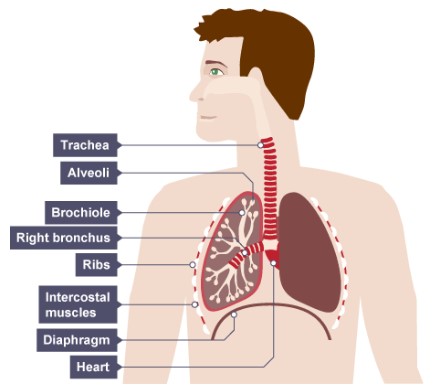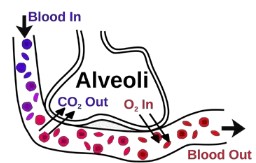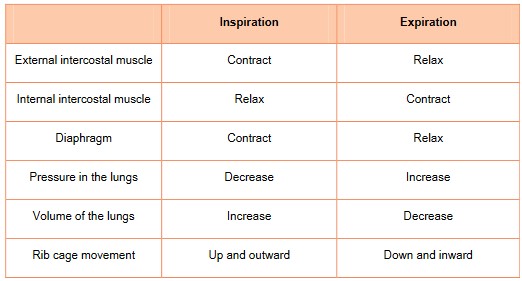Topic 6: Human physiology
6.4 Gas exchange
Ventilation :
- Small single celled organisms can easily diffuse gas in and out of the cell as long as they are in an environment where concentration gradients exist for passive diffusion.
- On the other hand human bodies are surrounded and protected by layers of skin. The cells in the tissue that need oxygen for respiration are too far away, too protected, and too numerous to allow direct diffusion with their environment.
- Therefore, humans need a system to keep a fresh supply of \(O^2\) and to get rid of excess \(CO_2\).
- The ventilation system provides a fresh supply of \(O_2\) in the alveoli, allowing the oxygen to diffuse into the blood capillaries surrounding them
- The oxygen is then transported to all the tissues in the body.
- The \(CO_2\) in the tissues is transported by the blood to the lungs, where it diffuses into the alveoli and is exhaled into the surrounding atmosphere.
- Inspiration: breathing in
- Expiration: breathing ou
Gas exchange system

- Gas \(\rightarrow \) Trachea \(\rightarrow \) Bronchi (single bronchus) \(\rightarrow \) Bronchioles \(\rightarrow\) Alveoli
- The trachea divides into two bronchi (left and right)
- Inside each lung the bronchi divide into many smaller tubes called bronchioles
- These numerous bronchioles form a tree root-like structure that spreads throughout the lungs
- Each bronchiole ends in a cluster of air sacs called alveoli

Alveoli
- Increase surface area for gas exchange
- Moist surface – gas can dissolve and diffuse easily
- Thin membrane (single cell thick) – short diffusion pathway
- Have networks of capillaries
- Consisted of two type of cells: Type I pneumocytes and Type II pneumocytes
⇒ Type I pneumocytes
- The walls of the alveoli are predominately made from a single layer of epithelial cells called Type I pneumocytes
- These are extremely thin – short diffusion pathway
- Since the alveoli are surrounded by capillaries that are also only one cell thick, oxygen and carbon dioxide have a very short distance to diffuse into the blood from the alveoli and out of the blood into the alveoli respectively
- The cells are permeable, which will aid diffusion
⇒ Type II pneumocytes
- About 5% of the inner surface of the alveoli consists of Type II pneumocytes
- These cells secrete a liquid made of proteins and lipids called surfactant in order to moisten the inner surface of alveoli
- This liquid allows oxygen to dissolve into the surfactant and then diffuse into the blood
- It will aid the gas to diffuse faster
- The surfactant also prevents alveoli from sticking up with each other
- They are also able to divide and become Type I pneumocytes, which means they can repair the damage
Muscle contraction in gas exchange
- External intercostal muscle and internal intercostal muscle works antagonistically; when one muscle contracts the other will relax
⇒ Inspiration
- External intercostal muscles contract pulling the ribs upwards and outwards.
- The diaphragm which is a flat sheet of muscle extending across the bottom of the rib cage contracts and flattens out.
- These two actions enlarge the volume in the lungs
- When the volume of the lungs increases, the pressure inside the lungs decreases and becomes lower than the pressure in the surrounding atmosphere.
- Since gas moves from higher pressure to lower pressure, air rushes into the lungs from the surrounding atmosphere to equalize the pressure.
⇒ Expiration:
- The external intercostal muscles relax and the diaphragm relax to its original shape (domed shape).
- This moves the ribs back down and inwards and decreases the volume of the thoracic cavity and the lungs.
- This decrease in volume increases the pressure inside the lungs.
- Since the pressure inside the lungs is now greater than the atmospheric pressure, and gas moves from high pressure to low pressure, air
rushes out of the lungs into the surrounding environment


Emphysema
- Emphysema is respiratory disease that is often linked to smoking
- Emphysema is characterized by the loss of elasticity of the alveoli in the lungs, resulting in the destruction of lung tissue over time
- Smokers lungs generally contain a high number of phagocytes/macrophages in their blood
- This will cause inflammatory response, releasing protease to break down connective tissue and capillaries
- This results in the destruction of elastic fibres of the alveolar walls
- The alveoli can become over-inflated and fail to recoil properly
- Small holes can also develop in the walls of the alveoli
- The alveoli can merge forming huge air spaces and a lower surface area.
- This destruction cannot be reversed
- It will cause insufficient gas exchange and low blood oxygen level
- Symptoms are difficult to breathe, coughing, loss of appetite and weight loss.

Lungs cancer
⇒ Smoking
- is the number one cause of lung cancer
- there is an extremely high correlation with the number of cigarettes an individual smokes in a day and the incidence of lung cancer
- Cigarettes contain a high number of carcinogens, such as polycyclic aromatic hydrocarbons and nitrosamines
- Second-hand smoke can also be considered a cause of cancer in non-smokers
⇒ Air Pollution
- Air pollution from exhaust fumes containing nitrogen oxides, fumes from diesel engines and smoke from burning carbon compounds such as coal are a minor cause of lung cancer. This depends on where in the world you live and the air quality.
⇒Radon Gas
- In some parts of the world, this radioactive gas can leak out of certain rocks such as granite, accumulating in poorly ventilated buildings
⇒ Lung cancer is a very serious disease and the consequences can be severe, especially if the cancer is not recognized early on.
